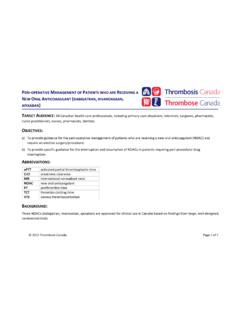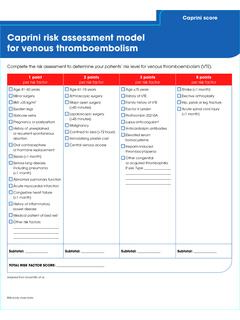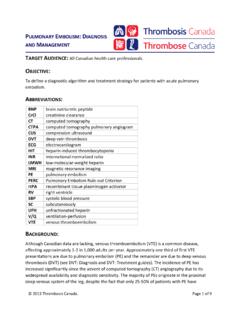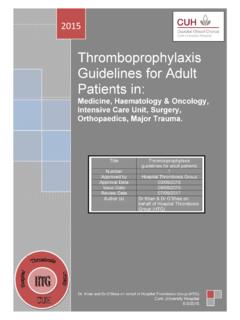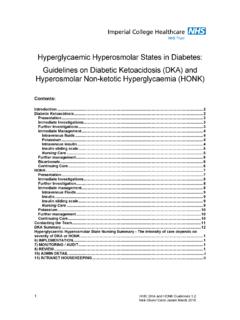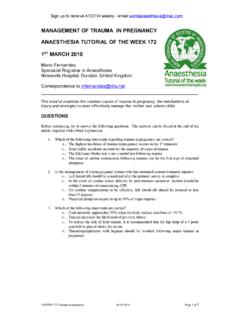Transcription of PERI OPERATIVE MANAGEMENT OF PATIENTS …
1 2013 Thrombosis Canada. Page 1 of 7 PERI- OPERATIVE MANAGEMENT OF PATIENTS WHO ARE RECEIVING A NEW ORAL ANTICOAGULANT (DABIGATRAN, RIVAROXABAN, APIXABAN) TARGET AUDIENCE: All Canadian health care professionals, including primary care physicians, internists, surgeons, pharmacists, nurse practitioners, nurses, pharmacists, dentists. OBJECTIVES: a) To provide guidance for the peri- OPERATIVE MANAGEMENT of PATIENTS who are receiving a new oral anticoagulant (NOAC) and require an elective surgery/procedure. b) To provide specific guidance for the interruption and resumption of NOACs in PATIENTS requiring peri-procedural drug interruption.
2 ABBREVIATIONS: aPTT activated partial thromboplastin time CrCl creatinine clearance INR international normalized ratio NOAC new oral anticoagulant PT prothrombin time TCT thrombin clotting time VTE venous thromboembolism BACKGROUND: Three NOACs (dabigatran, rivaroxaban, apixaban) are approved for clinical use in Canada based on findings from large, well-designed, randomized trials. 2013 Thrombosis Canada. Page 2 of 7 The peri- OPERATIVE MANAGEMENT of NOAC-treated PATIENTS aims to interrupt anticoagulant therapy so there is no (or minimal) residual anticoagulant effect at the time of surgery, and to ensure timely but careful resumption after surgery so as to not incur an increased risk for post- OPERATIVE bleeding.
3 There are 3 key considerations for peri- OPERATIVE MANAGEMENT : (1) Reliable or widely-available laboratory tests may be lacking to confirm no residual anticoagulant effects of NOACs. (2) Half-lives of NOACs differ and increase with worsening renal function, which affects when drug should be stopped before surgery. (3) NOACs have rapid onset of action, with a peak anticoagulant effect occurring 1-2 hours after oral intake. In the absence of laboratory tests to reliably measure their anticoagulant effect, the peri- OPERATIVE administration of NOACs should be anchored on: a) drug elimination half-life (with normal renal function), b) effect of renal function on drug elimination half-life, and c) bleeding risk associated with the surgery/procedure type and whether patient is to receive spinal/epidural anesthesia.
4 PERI- OPERATIVE MANAGEMENT : PATIENTS RECEIVING DABIGATRAN Pre- OPERATIVE MANAGEMENT (Table 1): Minor surgery/procedure. Stop dabigatran 1 day before surgery/procedure (skip 2 doses), which corresponds to 2 half-lives elapsed between stopping dabigatran and surgery. There may be a 12-25% anticoagulant effect at the time of surgery, which is acceptable for a minor surgery/procedure. Major surgery/spinal anesthesia. Stop dabigatran 2-3 days before surgery (skip 4-6 doses), which corresponds to 4-5 half-lives elapsed between stopping dabigatran and surgery. This ensures minimal (3-6%) residual anticoagulant effect at surgery and allows PATIENTS to have spinal anesthesia or high bleeding risk surgery ( intracranial or cardiac).
5 2013 Thrombosis Canada. Page 3 of 7 If impaired renal function, dabigatran is stopped earlier. Post- OPERATIVE MANAGEMENT (Table 2): Resumption of dabigatran 150 mg or 110 mg twice daily should be done cautiously after major surgery or in PATIENTS at increased bleeding risk, as this is a therapeutic-dose regimen which is higher than the regimen used for post- OPERATIVE VTE prevention (see Thromboprophylaxis: Surgical and Thromboprophylaxis: Orthopedic guides). PATIENTS RECEIVING RIVAROXABAN Pre- OPERATIVE MANAGEMENT (Table 1): Minor surgery/procedure. Stop rivaroxaban 1 day before surgery/procedure (skip 1 dose), which corresponds to 2 half-lives elapsed between stopping rivaroxaban and surgery.
6 Major surgery/spinal anesthesia. Stop rivaroxaban 2 days before surgery (skip 2 doses), which corresponds to 4-5 half-lives elapsed between stopping rivaroxaban and surgery. If impaired renal function (CrCl 30-50 mL/min), there are no data to guide practice but it is reasonable to allow an extra day of interruption to ensure elimination of any residual anticoagulant effect. Post- OPERATIVE MANAGEMENT (Table 2): Resumption of rivaroxaban 20 mg daily should be done cautiously after major surgery or in PATIENTS at increased bleeding risk, as this is a therapeutic-dose regimen which is higher than that for VTE prevention.
7 PATIENTS RECEIVING APIXABAN Pre- OPERATIVE MANAGEMENT (Table 1): Minor surgery/procedure. Stop apixaban 1 day before surgery/procedure (skip 2 doses), which corresponds to 2 half-lives elapsed between stopping apixaban and surgery. Major surgery/spinal anesthesia. Stop apixaban 2 days before surgery (skip 4 doses), which corresponds to 4-5 half-lives elapsed between stopping apixaban and surgery. 2013 Thrombosis Canada. Page 4 of 7 If impaired renal function (CrCl 30-50 mL/min), it is reasonable to allow an extra day of interruption to eliminate residual anticoagulant effect.
8 Post- OPERATIVE MANAGEMENT (Table 2): Resumption of apixaban 5 mg twice daily should be done cautiously after major surgery or in PATIENTS at increased bleeding risk, as this is a therapeutic-dose regimen which is higher than that for VTE prevention. Outcomes Relating to Proposed Peri- OPERATIVE MANAGEMENT : There are emerging data relating to the efficacy and safety of the proposed peri- OPERATIVE MANAGEMENT of NOAC-treated PATIENTS . In a substudy of RELY, an > 18,000-patient trial comparing dabigatran (150 mg or 110 mg) with warfarin for stroke prevention in atrial fibrillation, there were > 4,500 PATIENTS who had anticoagulant interruption for a surgery/procedure.
9 The incidence of peri- OPERATIVE bleeding was similar in dabigatran- and warfarin-treated PATIENTS , suggesting that dabigatran-treated PATIENTS can be safely managed peri-operatively. Similar substudies assessing the peri- OPERATIVE MANAGEMENT of rivaroxaban-treated and apixaban-treated PATIENTS will be forthcoming. SPECIAL CONSIDERATIONS: PATIENTS having Minor Procedures: In NOAC-treated PATIENTS who require dental procedures ( extraction, root canal), cataract surgery or minor skin procedures, it is likely safe to not interrupt anticoagulation (as is done in warfarin-treated PATIENTS ) but data to support such a practice are lacking.
10 PATIENTS with Impaired Renal Function: An approach to managing PATIENTS with mild-to-moderate renal dysfunction is shown in Table 2, but for PATIENTS with severe renal dysfunction (CrCl < 30 mL/min) who, typically, are ineligible for NOACs, peri- OPERATIVE MANAGEMENT is unclear. Need for Bridging in NOAC-treated PATIENTS : In general, the rapid offset and onset of action of NOACs obviates the need for heparin bridging as is done in selected warfarin-treated PATIENTS . 2013 Thrombosis Canada. Page 5 of 7 PEDIATRICS: There are no studies evaluating the use of NOACs in children, although studies are underway.


